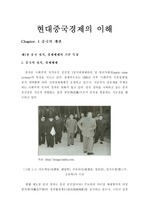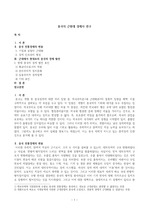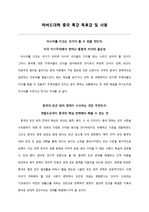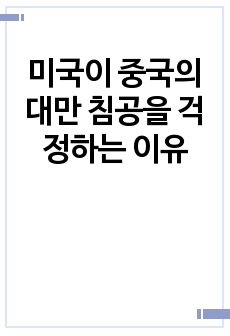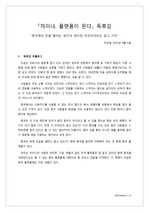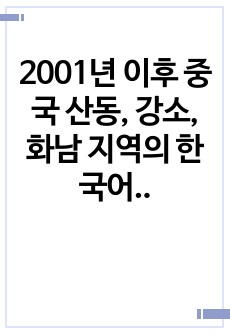

-
미리보기
소개
현대중국경제목차
없음본문내용
현대중국경제의 이해
Chapter. 1 중국의 개관
제1절 중국 정치, 경제체제의 기본 특징
1. 중국의 정치, 경제체제
중국은 사회주의 국가로서 공산당 1당지배체제하의 당-정국가체계(party-state system)의 특성을 지니고 있다. 경제적으로는 1992년 이후 ‘사회주의 시장경제’를 공식 채택함에 따라 시장경제체제가 운영되고 있으나, 지금까지 공유제를 주체로 하는 사회주의 국가의 성격은 변화지 않고 있다. 중국 정치를 지배하고 있는 중국 공산당은 지금껏 변함없는 집권 정당(執政黨)으로서 중국을 통솔하는 지도권을 행사하고 있다.
자료: http://image.baidu.com.
〔그림 1-1〕마오쩌둥(毛澤東, 맨앞쪽), 주은라이(周恩來, 정중앙), 덩샤오핑(鄧小平, 오른쪽)의 사진
현행 제도상 중국 정치는 중국 공산당(中共) 주도하의 다수당 체제형식의 다당합작제(多黨合作制)와 정치협상제도(政治協商制度)를 실시하고 있으나, 그러나 실질적으로는 중국 공산당이 중국의 유일한 정책결정기구로서 일당 집정제(一黨執政制) 형식을 유지하고 있다. 또한 중국 공산당은 대다수 노동인민의 이익을 대표한다고 함으로써 인민민주독재정치를 공표하고 있다. 즉 중국 헌법은 노동자계급이 지휘하고 노동자, 농민 연맹을 기초로 하는 인민민주독재정치체제를 채택하고 있다.참고자료
· 葉孔嘉(1994), “經濟改革綜述”, 載沃爾特加勤森(主編), 「中國經濟改革」, 北京: 社會科學文獻出版社.
· 宦(1996), “重型于增于西部地展模式再的思考", 制改革, 5, 85-88.
· 吳昻, 張建喜(1994), 「中國地方經濟分析」, 北京: 中國經濟出版社.
· 魏后凱(1995), 「區域經濟發展的新格局」, 云南: 云南人民出版社.
· 吳國光, 鄭永年(1995), 論中央-地方關係: 中國制度轉形中的一介軌心問題, 香港: 牛津大出版社.
· 謝慶奎(主編)(1996), 「當代中國政府」, 大: 遼寧出版社.
· 吳國光, 鄭永年(1995), 論中央-地方關係: 中國制度轉形中的一介軌心問題, 香港: 牛津大出版社.
· 國家統計局(編), 「中年」, http://www.stats.gov.cn/tjsj/ndsj/
· Calder, Kent E.(2005), "China`s energy diplomacy and its geopolitical implications," Reischhaur Center, Asia-Pacific Papers Series.
· Chung, Jae Ho(1995), “Studies of Central-provincial Relations in the People`s Republic of China: a Mid-term Appraisal," The China Quarterly, 142, 487-508.
· Chung, Jae Ho(2000), Central Control and Local Discretion in China: Leaderdship and Implementation During Post-Mao Decollectivization, Oxford: Oxford University Press.
· Halpern, Nina P.,(1992), “Information Flows and Policy Coordination in the Chinese Bureaucracy,” in Lieberthal and Lampton(eds.), Bureaucracy, Politics, and Decision Making in Post-Mao China, California: University of California.
· Huang, Yasheng(1994), “Information, Bureaucracy, and Economic Reforms in China and the Soviet Union,” World Politics, 47(1), 127-128.
· Li, P. P.(2005), The Puzzle of China`s Township-Village Enterprises: The Paradox of Local Corporatism in a Dual-Track Economic Transition, Management and Organization Review, 1(2), 197-224.
· Oi, J. C.,(1999), Rural China Takes Off: Institutional Foundations of Economic Reform, Berkely: University of California Press.
· Palley, Thomas I.(2006), “External contradictions of the Chinese development model: export-led growth and the dangers of global economic contradiction," Journal of Contemporary China, 15(46), 69-88.
· Perkins, D. H. and T. G. Rawski(2008). “Forecasting China’`s Economic Growth to 2025,” In China`s Great Economic Transformation. Ed. L. Brandt and T. G. Rawski, Cambridge and New York: Cambridge University Press.
· Prybyla, Jan S.(1996), “Who has the Emperor`s Clothes?: Economic Relationship between the Central and Local governments in Mainland China,” Issues & Studies, 32(7), 20-23.
· Shirk, Susan L.(2007), China: Fragile Superpower, Oxford: Oxford University Press.
· Tian, Xiaowen(1999), “Market Orientation and Regional Economic Disparities", Pot-Communist Ecnomics, 11(2), 161-172.
· Qian, Yingyi(1998), “A Theory of Shortage in Socialist Economics Based on the ‘Soft Budget Constraint`", American Economic Association, 84(1), 145-156.
· Wong, Christine P.(1991), “Central Planning and Local Participation under Mao: the Development of County-run Fertilizer Plants," in Gordon White(ed.), The Chinese State in the Era of Economic Reform: the Road to Crisis, London: Macmillan.
· http://english.cpc.people.com.cn.
· http://image.baidu.com.태그
-
자료후기
-
자주묻는질문의 답변을 확인해 주세요

꼭 알아주세요
-
자료의 정보 및 내용의 진실성에 대하여 해피캠퍼스는 보증하지 않으며, 해당 정보 및 게시물 저작권과 기타 법적 책임은 자료 등록자에게 있습니다.
자료 및 게시물 내용의 불법적 이용, 무단 전재∙배포는 금지되어 있습니다.
저작권침해, 명예훼손 등 분쟁 요소 발견 시 고객센터의 저작권침해 신고센터를 이용해 주시기 바랍니다. -
해피캠퍼스는 구매자와 판매자 모두가 만족하는 서비스가 되도록 노력하고 있으며, 아래의 4가지 자료환불 조건을 꼭 확인해주시기 바랍니다.
파일오류 중복자료 저작권 없음 설명과 실제 내용 불일치 파일의 다운로드가 제대로 되지 않거나 파일형식에 맞는 프로그램으로 정상 작동하지 않는 경우 다른 자료와 70% 이상 내용이 일치하는 경우 (중복임을 확인할 수 있는 근거 필요함) 인터넷의 다른 사이트, 연구기관, 학교, 서적 등의 자료를 도용한 경우 자료의 설명과 실제 자료의 내용이 일치하지 않는 경우
함께 구매한 자료도 확인해 보세요!
-
무역용어정리 11페이지
1. 자유무역(Free Trade) 자유무역(free trade)은 국가가 그 나라의 대외무역에 대해서 어떠한 국가적 간섭도 행하지 않고 그것을 완전히 국민의 자유에 방임하는 무역제도이다. 자유무역이란 국가의 무역 정책상 무역 및 외환면에서 재화와 용역의 자유로운 수출입을 보장하는 무역을 말한다. 이러한 무역은 상호 협정에 의하거나 공업화가 점.. -
[마케팅]중국 경제와 시장 연구 그리고 한국 기업의 영업전략 11페이지
2002年8月24日是中韩建交10周年纪念日。在过去的10年当中中韩关系是飞步发展的,两国交易量也保持着年持续增长。中国已经成为韩国海外投资的第二大市场, 在建交10年期间韩资企业加大了对中投资。而近年来韩对中投资额的加大,与本土业主的激烈竞争较逐中,韩国商品在中市场占有率呈下降趋势。中韩两国之间的贸易交易和投资预期将会保持持续增长。产业资源部预计2008年北京奥运会将会进一步扩大中韩交易规模。 .. -
[중국인][중국인의 사상][중국인의 국민성][중국인의 특징]중국인의 사상과 국민성 및 특징(고대 중국인 사상, 중국인 의식.. 12페이지
어느 민족이나 자신들의 독특한 성격이나 습관을 형성해가는 데 지형과 기후가 커다란 요인으로 작용한다. 특정한 역사와 문화가 오랜 세월 동안 작용하여 민족성을 구축해온 것이다. 좀 더 세분한다면 한 국가나 민족 내부에서도 지역에 따른 특성이나 기질이 존재할 것이다. 중국은 5천년이 넘는 역사와 우리나라의 약 50배에 달하는 면적을 지닌 국가이다. 중국은 지역.. -
(주식) 증권용어사전 33페이지
* 동시호가(simultaneous bids and offers) 증권시장에서 매매입회를 시작한 처음은(시초 5분간) 접수된 호가의 시간 선후가 분명치 못하게 되는데, 이를 동시호가로 취급하여 가격우선과 수량우선의 원칙만 적용하는 경우를 말한다. * 상환주식(redeemable stock) 원금이 상환된다는 점에서 사채와 비슷한 특수형태의 주식으로서 .. -
현대 중국의 도로망, 철도망 4페이지
1. 철도망 ① 국제노선 중국이 시짱자치구와 신장위구르자치구, 헤이룽장성, 윈난성의 철로를 주변 국가와 연결하는 대규모 국제철도 건설에 들어가기로 했다. 중국에는 현재 러시아와 몽골, 베트남을 잇는 5개의 국제철도가 가설된 상태다. 이에 더해 대규모 국제철도가 건설되면 중국은 주변 국가와 거미줄 같은 물류망을 구축하게 될 뿐 아니라 주변 ..
찾으시던 자료가 아닌가요?
지금 보는 자료와 연관되어 있어요!
문서 초안을 생성해주는 EasyAI
